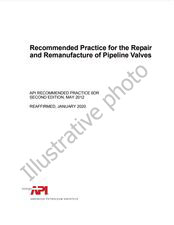We need your consent to use the individual data so that you can see information about your interests, among other things. Click "OK" to give your consent.

API STD 65-2-ed.2
Isolating Potential Flow Zones During Well Construction
Translate name
STANDARD published on 1.11.2016
The information about the standard:
Designation standards: API STD 65-2-ed.2
Publication date standards: 1.11.2016
SKU: NS-1140578
The number of pages: 96
Approximate weight : 319 g (0.70 lbs)
Country: American technical standard
Category: Technical standards API
Annotation of standard text API STD 65-2-ed.2 :
API STD 65-2, 2nd Edition, December 2010 - Isolating Potential Flow Zones During Well Construction
Overview
This standard contains practices for isolating potential flow zones, an integral element in maintaining well integrity. The focus of this standard is the prevention of flow through or past barriers that are installed during well construction. Barriers that seal wellbore and formation pressures or flows may include mechanical barriers such as seals, cement, or hydrostatic head, or operational barriers such as flow detection practices. Operational barriers are practices that result in activation of a physical barrier. Though physical barriers may dominate, the total system reliability of a particular design is dependent on the existence of both types of barriers.
Objectives
The objectives of this guideline are two-fold. The first is to help prevent and/or control flows just prior to, during, and after primary cementing operations to install or “set” casing and liner pipe strings in wells. Some of these flows have caused loss of well control. They threaten the safety of personnel, the environment, and the drilling rigs themselves. The second objective is to help prevent sustained casing pressure (SCP), also a serious industry problem.
API RP 90, provides guidelines on managing annular casing pressure (ACP) including SCP, thermal casing pressure, and operator-imposed pressure. These guidelines include monitoring, diagnostic testing, establishing the maximum allowable wellhead operating pressure (MAWOP), documenting annular casing pressure, and risk assessment methodologies.
Background and Technology Review
A detailed background and technology review are in Annex A. Historical data, perspectives, studies, statistics, lessons learned, etc. are included. All this information has been written to help explain how some practices work, have become proven or invalidated, or had performance limitations placed upon their application.
Conditions of Applicability
The process of barrier element selection and installation (including cement) is governed by the anticipated presence or absence of potential flow zones that require isolation for well integrity or regulatory purposes. This document applies only when it is deemed necessary that a potential flow zone be isolated. The guidance from this document covers recommendations for pressure-containment barrier (cement, packers, etc.) design and well construction practices that affect the zonal isolation process to prevent or mitigate annular fluid flow or pressure. These practices may also help prevent loss of well control (LWC) incidents and minimize the occurrence of SCP during well construction and production.
As presented earlier herein, the content of this document is not all inclusive and not intended to alleviate the need for detailed information found in textbooks, manuals, technical papers, or other documents. Included are those practices (well design, drilling, completion, etc.) that may positively or negatively affect pressure-containment barrier sealing performance along with methods to enhance the positive effects and to minimize any negative ones.
This document does not address shallow water flow zones in deepwater wells which are covered in API RP 65.
Well Planning and Drilling Plan Considerations
Annex B includes consideration in well planning and drilling plan determinations, such as evaluation for flow potential, site selection, shallow hazards, deeper hazard contingency planning, well control planning for fluid influxes, planning for lost circulation control, regulatory issues and communications plans, planning the well, pore pressure, fracture gradient, drilling fluid weight, casing plan, cementing plan, drilling plan, wellbore hydraulics, wellbore cleaning, barrier design, and contingency planning. These elements factor into the planning of the well to enhance the barrier sealing performance.
In some cases, pre-spud information gathered from offset well(s) and/or from high resolution seismic surveys can be used to indicate flow potential for a particular drilling prospect. Any relevant information should be communicated to the appropriate service provider for incorporation into the design for a particular fluid (drilling fluid or cement) and for preparing engineering and operations procedures.
Drilling the Well
Annex C gives a general overview of drilling the well and some of the factors that might be considered by the drilling group. Some of those factors may include general practices while drilling, monitoring and maintaining wellbore stability, mitigating lost circulation, and planning and operational considerations. There may be other factors to consider such as type and location of the well being drilled. These factors should be considered during the drilling of the well to enhance the barrier sealing performance. Detailed discussion of these factors is included in Annex C and may be mentioned in other sections.
Summary of Considerations
Isolating a potential flow zone with cement is an interdependent process. Individual process elements such as slurry design and testing, applied engineering and job execution all impact the ability to successfully install a cement barrier. Superimposed upon these elements are the conditions found in the well at the time of cementing.
Certain cementing process elements contained in Annex D may be individually critical to isolating a potential flow zone
We recommend:
Technical standards updating
Do you want to make sure you use only the valid technical standards?
We can offer you a solution which will provide you a monthly overview concerning the updating of standards which you use.
Would you like to know more? Look at this page.



 Cookies
Cookies
